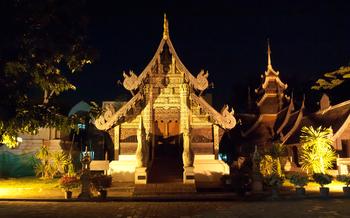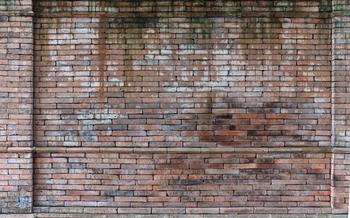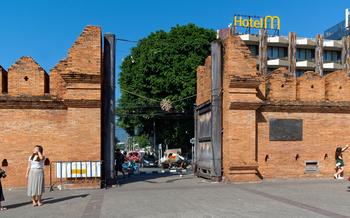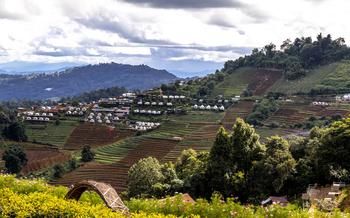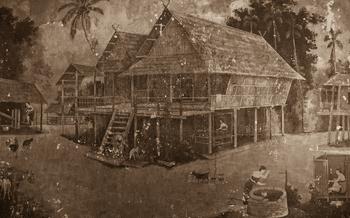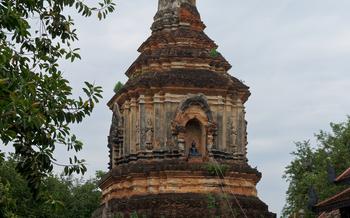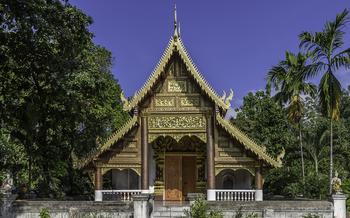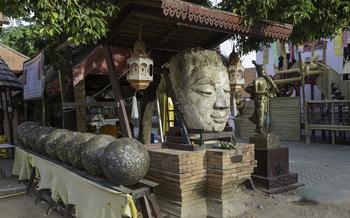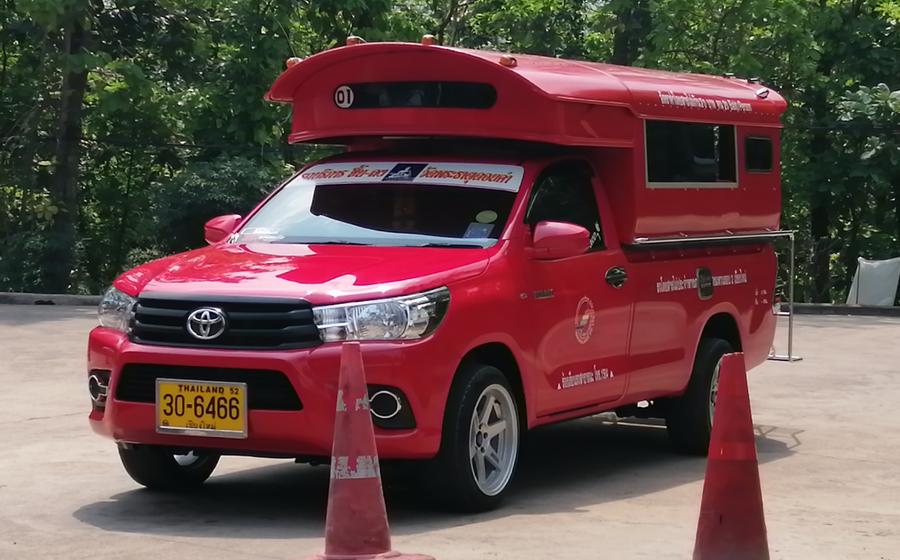
Doi Kham Temple
- Doi Kham Temple: A Majestic Temple in Chiang Mai
- Reaching Doi Kham Temple: A Scenic Adventure
- Transportation Options from Chiang Mai City
- Driving Directions and Route Details
- Duration and Estimated Travel Time
- Insider Tips for a Smooth Journey
- Exploring the Temple Grounds: Serenity and Beauty
- Marveling at the Intricate Murals: Stories in Color
- Exploring the Surrounding Gardens: Nature's Embrace
- Learning About Lanna Culture: A Heritage Revealed
- Attending Festivals and Events: A Vibrant Experience
- Visiting the Royal Pavilion: A Touch of Majesty
- Enjoying Local Cuisine: A Culinary Adventure
- Shopping for Souvenirs: Unique and Memorable
- Insider Tip: Finding the Best Deals
- Accommodations Near the Temple: Comfort and Convenience
- Photography Tips for Capturing the Beauty
- Respectful Behavior and Etiquette: A Cultural Guide
- Insider Tip: Unveiling the Hidden Gem
Doi Kham Temple: A Majestic Temple in Chiang Mai
Doi Kham Temple, situated atop Doi Kham Mountain, is a revered Buddhist temple that holds a significant place in Chiang Mai's religious and cultural heritage. Its history dates back to the 13th century when it was constructed during the reign of King Mengrai, the founder of the Lanna Kingdom. The temple was initially known as Wat Suthep, but later renamed Doi Kham Temple due to its location on the mountain.
Its architectural design showcases intricate Lanna-style elements, characterized by sweeping roofs and intricate carvings that adorn the temple's structures. The main highlight is the golden chedi, or stupa, which rises majestically above the temple complex. Visitors are captivated by the temple's serene atmosphere and the stunning views of the surrounding mountains and valleys, making it a popular destination for both pilgrims and tourists alike.
Reaching Doi Kham Temple: A Scenic Adventure
Transportation Options from Chiang Mai City
To reach Doi Kham Temple from Chiang Mai city, you have several transportation options to choose from. If you prefer a leisurely and scenic journey, renting a motorbike or bicycle is a great option. The ride takes about an hour and offers stunning views of the countryside. Alternatively, you can opt for a more convenient mode of transport by taking a taxi or hiring a private car with a driver. This option allows for a more relaxed trip and ensures you arrive at the temple without any hassles.
Driving Directions and Route Details
If you choose to drive to Doi Kham Temple, the journey takes approximately 45 minutes from Chiang Mai city. Head north on Highway 107 (Chiang Mai-Hod Road) and continue for about 12 kilometers. Turn right at the intersection and follow the signs for Doi Kham Temple. The road winds through picturesque landscapes, offering glimpses of lush forests and rolling hills. Along the way, you'll pass by several other temples and historical sites, adding to the charm of the journey.
Duration and Estimated Travel Time
The total travel time from Chiang Mai city to Doi Kham Temple varies depending on the chosen mode of transport. By motorbike or bicycle, the journey takes approximately 60-75 minutes, allowing you to savor the scenic route. If you opt for a taxi or private car, the travel time is typically shorter, ranging from 45 to 60 minutes. Make sure to factor in additional time for exploring the temple grounds and taking in the serene atmosphere.
Insider Tips for a Smooth Journey
- Embark on your journey early in the morning to avoid the midday heat and crowds.
- If renting a motorbike or bicycle, ensure it's in good condition and that you have a valid driving license.
- For a more comfortable ride, consider hiring a private car with a knowledgeable driver who can provide insights into the area.
- Don't forget to bring water, sunscreen, and insect repellent, as the temple grounds are vast and mostly unshaded.
Exploring the Temple Grounds: Serenity and Beauty
As you step through the gates of Doi Kham Temple, a sense of tranquility envelops you. The temple complex is thoughtfully laid out, with manicured gardens and serene courtyards that invite contemplation. The main structures of the temple include the chedi, a tall, bell-shaped stupa, and the viharn, a large assembly hall.
Take your time to admire the intricate details of the chedi. Its gleaming white surface is adorned with intricate carvings and colorful tiles, each telling a story from Buddhist mythology. Inside the viharn, you'll find a majestic Buddha image surrounded by vibrant murals that depict scenes from the life of Buddha and stories from the Jataka tales.
The peaceful atmosphere of Doi Kham Temple is palpable. Whether you choose to sit in silent meditation, wander through the gardens, or simply soak in the serene surroundings, the temple offers a sanctuary for spiritual reflection and inner peace.
Tips for Capturing the Best Photos:
- Golden Hour Magic: Visit the temple during sunrise or sunset to capture the warm, golden light that casts a magical glow on the temple's architecture.
- Composition and Angles: Experiment with different angles and compositions to create visually appealing shots. Try capturing the temple's reflection in the nearby pond or framing it against the backdrop of the surrounding mountains.
- Details and Close-ups: Don't forget to focus on the intricate details of the temple's architecture, such as the carvings on the chedi or the murals inside the viharn. Close-up shots can reveal hidden treasures that you might miss from a distance.
Marveling at the Intricate Murals: Stories in Color
The walls of Doi Kham Temple are adorned with exquisite murals, a testament to the artistic prowess of Lanna artisans. These murals depict scenes from Buddhist mythology, tales of the Buddha's life, and legends from Lanna history. The vibrant colors and intricate details bring the stories to life, captivating visitors with their beauty and symbolism.
Each mural tells a unique story, often conveying moral lessons or religious teachings. Look for the mural depicting the story of the Buddha's birth, where he emerges from his mother's side, surrounded by celestial beings. Another mural portrays the temptation of the Buddha by Mara, the evil tempter, who tries to distract him from his path to enlightenment.
The murals are not merely decorative; they serve an educational purpose, teaching visitors about the life and teachings of the Buddha, as well as the history and culture of the Lanna people. Take your time to study the murals, and you'll be rewarded with a deeper understanding of the temple and its significance.
To fully appreciate the murals, try to understand the symbolism and iconography used by the artists. For example, the lotus flower often represents purity and enlightenment, while the elephant symbolizes strength and wisdom. By understanding these symbols, you'll gain a deeper appreciation for the artistry and depth of the murals.
Exploring the Surrounding Gardens: Nature's Embrace
As you wander through the temple complex, be sure to take some time to explore the surrounding gardens. Lush vegetation and vibrant flowers create a serene and inviting atmosphere, making the gardens a perfect place to relax and enjoy the natural beauty of Doi Kham Temple.
Well-manicured walking paths meander through the gardens, leading visitors past tranquil ponds, cascading waterfalls, and colorful flowerbeds. Take a leisurely stroll and soak in the tranquil ambiance as the gentle breeze carries the fragrance of jasmine and frangipani blossoms through the air.
At the highest point in the gardens, you'll find a pavilion that offers panoramic views of the valley below. Admire the stunning vistas as you rest on a bench and take in the tranquility of the surroundings. This is the perfect spot to capture some breathtaking photos of the temple and the surrounding landscape.
Learning About Lanna Culture: A Heritage Revealed
Doi Kham Temple, a testament to the rich Lanna culture, offers a profound insight into the history and traditions of this once-powerful kingdom. Lanna culture, with its unique language, cuisine, and customs, has left an indelible mark on the temple's architecture, artwork, and overall atmosphere.
Architectural elements such as the intricate roof designs, graceful stupas, and elegant viharns reflect the characteristic Lanna style. The temple's design also showcases the influence of Buddhism and animism, two dominant religious beliefs in the Lanna Kingdom.
For a deeper understanding of Lanna culture, take the time to explore the temple's murals and sculptures, which depict scenes from Lanna history, mythology, and daily life. These works of art provide a glimpse into the beliefs, values, and traditions of the Lanna people.
Insider Tip: Engage with the local monks or knowledgeable guides who can offer insights into the cultural and historical significance of the temple. Their stories and explanations will bring the Lanna heritage to life, making your visit even more meaningful.
Attending Festivals and Events: A Vibrant Experience
Doi Kham Temple, a sacred site and cultural hub, comes alive during festivals and events that showcase the rich traditions of the Lanna Kingdom. These celebrations offer a unique opportunity to immerse yourself in the vibrant culture of Northern Thailand.
The temple's annual Songkran Festival, held in April, marks the Thai New Year with water splashing, parades, and merit-making ceremonies. During the Yi Peng Festival, which coincides with the full moon in November, visitors can witness the release of sky lanterns, creating a magical spectacle in the night sky.
Other notable events include the Lanna Cultural Festival and the Doi Kham Temple Fair, which showcase traditional dances, music, and handicrafts. These festivals are not only a feast for the eyes and ears but also an opportunity to interact with locals, learn about their customs, and experience the warm hospitality of the Lanna people.
Insider Tip: To fully immerse yourself in the festivities, consider staying in Chiang Mai for a few days and attending multiple events. You'll have the chance to witness the diversity of Lanna culture and create lasting memories of your time in this enchanting region.
Visiting the Royal Pavilion: A Touch of Majesty
Within the sacred grounds of Doi Kham Temple lies a hidden gem that exudes an aura of royalty and grandeur—the Royal Pavilion. Steeped in history and cultural significance, this pavilion holds a special place in the hearts of the Lanna people. Built in the traditional Lanna architectural style, the pavilion boasts intricate carvings, delicate murals, and a graceful silhouette that blends seamlessly with the temple's surroundings.
Once used as a resting place for the Lanna monarchy during their visits to the temple, the Royal Pavilion now stands as a testament to the deep connection between the monarchy and the Buddhist faith. As you step inside, you'll be greeted by an opulent interior adorned with vibrant colors, intricate designs, and a palpable sense of history.
Be sure to take your time to admire the exquisite craftsmanship that adorns every corner of the pavilion. From the ornate pillars and vaulted ceilings to the delicate murals depicting scenes from Lanna history and mythology, every detail speaks to the artistry and devotion of the Lanna people.
As you wander through the Royal Pavilion, imagine the royal processions and ceremonies that once took place within its walls. Feel the weight of history as you soak in the stories whispered by the ancient timbers and the reverence that still lingers in the air. This is a place where the past and present intertwine, creating a truly magical and unforgettable experience.
Insider tip: For a truly immersive experience, plan your visit to the Royal Pavilion during one of the temple's many festivals or ceremonies. Witness the pavilion come alive with vibrant colors, lively performances, and the infectious spirit of the Lanna people. It's a sight that will stay with you long after you leave Doi Kham Temple.
Enjoying Local Cuisine: A Culinary Adventure
In the vicinity of Doi Kham Temple, visitors can embark on a culinary adventure, savoring the tantalizing flavors of traditional Lanna cuisine. Local restaurants and food stalls offer a mouthwatering array of dishes, each bursting with unique aromas and textures. Indulge in the delectable flavors of khao soi, a rich and flavorful curry noodle soup, or tantalize your taste buds with sai ua, a succulent grilled sausage infused with herbs and spices. For a truly immersive experience, venture into the local markets, where you can interact with friendly vendors and discover hidden culinary gems. Bargaining is a common practice, so don't hesitate to engage in friendly negotiations to secure the best prices. Embrace the opportunity to sample the diverse culinary delights of the region and savor the authentic flavors of Lanna cuisine.
- Insider Tip
To truly immerse yourself in the local culinary scene, seek out the hidden gems frequented by the locals. Ask your guide or fellow travelers for recommendations on authentic restaurants that serve traditional dishes passed down through generations. These hidden culinary havens often offer the most authentic and delicious experiences, allowing you to savor the essence of Lanna cuisine at its finest.
Shopping for Souvenirs: Unique and Memorable
As you leave the serene embrace of Doi Kham Temple, don't miss the opportunity to take home a piece of Chiang Mai's rich culture and heritage. Several local markets and shops are located in the vicinity of the temple, offering a treasure trove of unique and memorable souvenirs.
From intricately woven textiles and hand-painted ceramics to intricate silver jewelry and hand-carved wooden artifacts, these markets are a haven for souvenir hunters. You'll find everything from small trinkets to larger decorative pieces that will serve as a lasting reminder of your time in Chiang Mai.
When shopping at these local markets, don't be afraid to engage in friendly bargaining. It's a time-honored tradition in Thailand, and the vendors are usually open to negotiating prices. Remember to be respectful and offer a fair price while enjoying the interaction and learning about the local culture.
Insider Tip: Finding the Best Deals
To truly uncover the hidden gems and find the best deals, venture beyond the main tourist areas and explore the smaller shops and stalls. Often, these hidden gems offer unique and authentic items at more reasonable prices. Ask locals for recommendations or simply wander around the charming streets, allowing your curiosity to guide you.
Accommodations Near the Temple: Comfort and Convenience
For those seeking a comfortable and convenient stay near Doi Kham Temple, there is a range of hotels and guesthouses to choose from. These accommodations offer a variety of amenities and facilities to cater to travelers' needs. Whether you seek budget-friendly options or luxurious experiences, you'll find suitable choices in the vicinity of the temple.
To ensure the best deals and availability, consider booking your accommodation in advance, especially if you plan on visiting during peak tourist seasons. Many hotels and guesthouses offer online booking platforms, making it easy to secure your stay.
For a unique accommodation experience, consider staying at a traditional Lanna-style guesthouse or homestay. These accommodations often provide a more immersive cultural experience, allowing you to connect with local traditions and lifestyles.
Insider tip: For a truly special experience, opt for a guesthouse or homestay that offers stunning views of the surrounding mountains and valleys. This will allow you to wake up to breathtaking vistas each morning and enjoy the tranquility of the temple grounds from the comfort of your room.
Photography Tips for Capturing the Beauty
The allure of Doi Kham Temple is best captured through the lens of a camera. To make the most of your photographic adventure, consider visiting during the golden hours of sunrise or sunset, when the soft light casts a magical glow on the temple's structures. Experiment with different camera settings to achieve optimal exposure and depth of field. Utilize a tripod for stability and to avoid camera shake, especially when capturing long exposure shots.
Compose your shots carefully, using leading lines such as the temple's walkways or surrounding trees to draw the viewer's eye towards the main subject. Play with different angles and perspectives to create dynamic and visually interesting compositions. Don't be afraid to get low or high to capture unique vantage points.
For close-up shots, focus on the intricate details of the temple's architecture, such as the delicate carvings on the chedi or the vibrant murals adorning the viharn. Remember to adjust your camera's focus and exposure settings accordingly.
Most importantly, take your time to explore the temple grounds and find unique compositions that showcase the beauty of this sacred site. Patience and a keen eye will reward you with stunning photographs that capture the essence of Doi Kham Temple.
Respectful Behavior and Etiquette: A Cultural Guide
As you embark on your journey to Doi Kham Temple, it is essential to be mindful of local customs and traditions to ensure a respectful and enriching experience. When visiting the temple, appropriate dress is crucial. Opt for modest attire that covers your shoulders and knees, avoiding revealing or overly casual clothing. Upon entering the temple grounds, remove your shoes as a sign of respect and place them neatly in the designated racks.
Inside the temple, maintain a respectful demeanor by speaking softly and avoiding loud conversations. Refrain from touching or leaning against the Buddha image or other sacred objects. When making offerings, follow the local customs, such as placing a small donation in the designated box and lighting incense sticks.
Remember, the temple is an active place of worship for the local community. Be mindful of ongoing ceremonies or prayers and avoid causing any disturbances. By observing these guidelines, you can contribute to preserving the sacred atmosphere of Doi Kham Temple and demonstrate your respect for the local culture.
Insider Tip: Unveiling the Hidden Gem
Beyond the temple grounds, a hidden gem awaits those willing to venture off the beaten path. Nestled amidst the surrounding hills, a lesser-known viewpoint offers breathtaking panoramas of the temple and the valley beyond. To reach this secret spot, follow the path leading north from the temple complex. After a short walk, you'll find yourself at a clearing with unobstructed views of Doi Kham Temple, framed by lush greenery and rolling mountains. This secluded viewpoint is the perfect place to soak in the tranquility of the surroundings and capture stunning photographs that will forever immortalize your visit to this sacred site. Remember to tread lightly and respect the natural environment as you explore this hidden gem.

